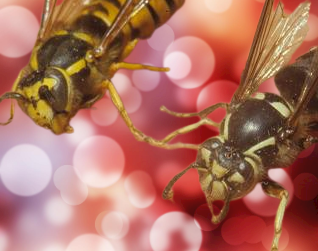When it comes to recognizing pests, there are sometimes challenges involved in matching the appropriate name with the correct appearance of the insect. Regarding Bald-Faced Hornets and Yellow Jackets, this is particularly challenging. They share a lot of visual characteristics, making differentiation challenging.
The bald-faced hornet is a big kind of stinging insect that is seen quite regularly on Long Island between the summer and the beginning of October. Although they are commonly referred to as “hornets,” these venomous insects belong to the same family as paper wasps and yellow jackets, even though they are commonly referred to as “hornets.”
Wasps belonging to the subspecies known as yellow jackets possess a distinct yellow color that makes them easy to identify. Yellow jackets are mostly found all over the world. The bald-faced hornets, despite being called hornets, are yellow jackets with black and white stripes. Their white and black color resembles that of hornets, yet their body structure is similar to that of yellow jackets.
Bald-faced hornet vs Yellow-jacket Sting
The Vespula genus includes the familiar yellow jacket and the bald-faced hornet, both of which lack hair on their bodies but display a glossy appearance. They both are more lightweight than bees and possess the ability to inflict several stings on their prey. Scavenger insects like the bald-faced hornet and the yellow jacket are considered useful since they greatly reduce the populations of harmful insects in gardens and farms.
Bald-faced hornets possess non-barbed stingers, thus they sting several times. The venom in the sting of a Bald-Faced Hornet is unpleasant. The venom that is injected by the stinger often causes the affected area to be painful, itchy, and swollen for approximately twenty-four hours. However, yellow jackets usually die after stinging someone because their stingers become entangled in the flesh. A baldfaced hornet’s sting is very painful, but hornet stings are less often and typically more painful.
Bald-faced hornet vs Yellow-jacket Nest
When it comes to nest construction, yellow jackets and bald-faced hornets are pretty much identical. Yellow jackets typically construct their nests in crevices, in contrast to the spherical nests that bald-faced hornets make in trees or buildings. Nests of bald-faced hornets are typically eliminated by cutting them down during treatment, whereas nests of yellow jackets are typically so effectively hidden that they are often left in place. The construction of these nests is quite similar despite the differences in site choices.
Their nests share certain similarities, but there are also notable distinctions. The nest of a hornet resembles an extended cone, whereas the nest of a yellowjacket is typically shapeless. There are no wax-producing glands in either of these bugs. So they create their nest from a paper-like material that is created from wood (or mud) and mixed with their saliva.
A bald-faced hornet’s nest is highly unusual. It begins as a small structure and expands as the colony grows throughout the summer. These nests are quite large, measuring up to 14 inches in diameter and far more than 24 inches in length at their longest point. Most of the time, the nests of yellow-jacket are built underground. A nickel-sized or smaller opening serves as the only entrance to the nest. Other potential habitats include building wall cavities, hollow trunks or logs, and rooftops.
Bald-faced hornet vs Yellow-jacket Control
The initial decision is whether or not control is genuinely required. There are several considerations to keep in mind:
- Many insects that humans consider pests are prey for hornets and yellowjackets, despite their bad reputation. They are also consumed by insects, birds, skunks, bears, and other animals.
- Colonies of hornets and yellowjackets, in contrast to honey bees, decline annually.
- If a hornet nest is located high in a tree, it is best to wait until late fall or early winter for the colony to die out.
- The nest frequently deteriorates over time due to weather or attacks by hungry birds. Colony eradication is often necessary if a nest is in a dangerous area, or if someone is extremely allergic to bee or wasp stings.
- It is best to spray the pesticide infront of the opening of the nest. Any time of the day is appropriate for this, however, the majority of wasps are most likely to be in the nest around dusk.
- Any type of the “Wasp & Hornet” aerosol sprays that shoot a stream of insecticide about 10–12 feet long are also used for effective results.
Bald-faced hornet vs Yellow-jacket Poison
The stings from Bald-faced hornets contain venom that causes pain, itching, and swelling for around 24 hours. Allergy reactions to stings from bald-faced hornets are about the same as those from other insects.
On the other side, being stung by a yellow jacket with a contaminated stinger often result in illnesses or blood poisoning. A yellow jacket sting often results in the development of various serious medical disorders in addition to pain and potential allergic reactions. Sometimes the consequences of this behavior can even be fatal.



